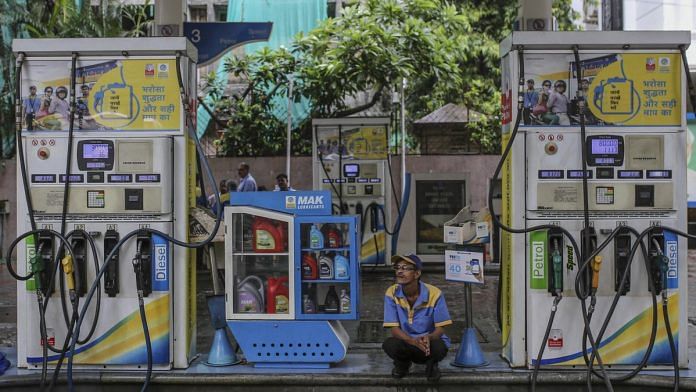New Delhi: Prices of petrol have increased by just about 50 paise on an average since 10 March, when the Lok Sabha elections were announced, even as global crude oil prices have soared to over $75 a barrel for the first time in 2019.
Between 10 March, when the global crude price was at $66.58, and Thursday, global oil prices have increased about 12 per cent, but in India, petrol prices have increased by less than a per cent. According to Indian Oil’s price basket, the price in Delhi Wednesday stood at Rs 72.95 per litre, while in Mumbai, it was Rs 78.52 for a litre.
The price of diesel, which was Rs 67.44 per litre in Delhi on 10 March, has gone down to Rs 66.46.
The lack of price rise is also putting pressure on oil marketing companies, including Indian Oil Corporation, Hindustan Petroleum Corporation and Bharat Petroleum Corporation.
“It is obvious that fuel prices have not risen because elections are underway, but this is temporary, as oil prices globally are rising. Now there will be additional pressure as the US has ended the (Iran) waivers,” an analyst told ThePrint.
Also read: US ban on Iran oil exports gives opposition fresh ammo to take on Modi govt
Contrast with last year
On 5 November 2018, when the global crude price was $73.17 per barrel (about a dollar lower than right now), the petrol price in Delhi was Rs 78.56.
Even when the global prices came down below $70 over the next few days, the petrol price in Delhi remained between Rs 77 and Rs 78.
In Mumbai, the price was over Rs 84 on 5 November, and stayed above the psychological mark of Rs 80 till the end of the month.
Fluctuations in crude prices
After touching over $86 a barrel on 3 October 2018, global crude prices dropped to a level of about $54 a barrel in December. However, prices started increasing again since January, and have already risen about 38 per cent.
What is also worrisome is the fact that India has not managed to increase its domestic oil production. While India’s crude production dropped 4 per cent between April 2018 and February 2019, imports have been steadily rising. India’s crude oil imports rose from 202.85 million metric tonnes in 2015-16 to about 217 million metric tonnes in 2017-18.
A rise in imports will have a direct impact on the country’s current account deficit — the difference between outflow and inflow of foreign exchange — and other macro-economic indicators.
Also read: US’ Iran oil waiver cancellation could impact India strategically, not economically
Impact of US cancellation of Iran oil waiver
Analysts say that both petrol and diesel will get dearer once the elections are over. Supply and price could both come under pressure, with the US deciding to end the import waivers on Iranian oil extended to India and seven other countries. The waivers expire on 2 May.
Two analysts who did not wish to be named told The Print that global crude prices could easily breach the level of $80-85 a barrel, pushing up domestic prices.
However, Dharmendra Pradhan, the petroleum & natural gas minister, tried to allay fears, saying that India was well-prepared to deal with the situation and plans were in place to “ensure that there is adequate supply of crude oil to Indian oil refineries from May 2019 onwards”.
“There will be additional supplies from other major oil producing countries from different parts of the world. The Indian refineries are fully prepared without any problem to meet the national demand for petrol, diesel and other petroleum products in the country,” he said in a tweet.
Besides India, countries including China, Japan, Taiwan, South Korea, Turkey, Italy and Greece had been granted waiver but on the condition that they would have to reduce their purchases from Iran.
The alternate oil supply is likely to come from Saudi Arabia, Mexico and Kuwait. About 80 percent of India’s oil requirements are imported.
Also read: US needs India as an ally against China and can’t afford to bully it over Iran oil, trade







Indians will wake up on 24th May with a slight hangover.